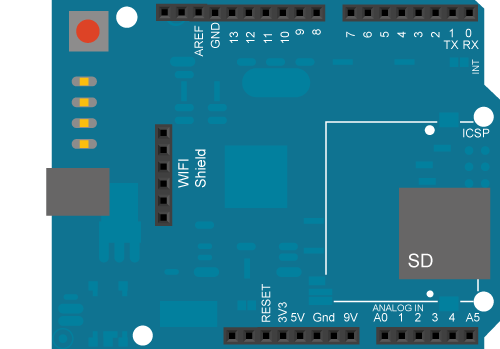Send and Receive UDP String
This sketch waits for a UDP packet on a local port. When a valid packet is received, an acknowledge packet is sent back to the client on a specified outgoing port.
Hardware Required
- Arduino WiFi Shield
- Shield-compatible Arduino or Genuino board
Circuit
The WiFi shield uses pins 10, 11, 12, and 13 for the SPI connection to the HDG104 module. Digital pin 4 is used to control the slave select pin on the SD card.
You should have access to a 802.11b/g wireless network that connects to the internet for this example. You will need to change the network settings in the sketch to correspond to your particular networks SSID.
image developed using Fritzing. For more circuit examples, see the Fritzing project page
In the above image, the Arduino or Genuino board would be stacked below the WiFi shield.
Code
WiFi UDP Send and Receive String
This sketch wait an UDP packet on localPort using a WiFi shield.
When a packet is received an Acknowledge packet is sent to the client on port remotePort
Circuit:
* WiFi shield attached
created 30 December 2012
by dlf (Metodo2 srl)
*/
#include <SPI.h>
#include <WiFi.h>
#include <WiFiUdp.h>
int status = WL_IDLE_STATUS;
char ssid[] = "yourNetwork"; // your network SSID (name)
char pass[] = "secretPassword"; // your network password (use for WPA, or use as key for WEP)
int keyIndex = 0; // your network key Index number (needed only for WEP)
unsigned int localPort = 2390; // local port to listen on
char packetBuffer[255]; //buffer to hold incoming packet
char ReplyBuffer[] = "acknowledged"; // a string to send back
WiFiUDP Udp;
void setup() {
//Initialize serial and wait for port to open:
Serial.begin(9600);
while (!Serial) {
; // wait for serial port to connect. Needed for native USB port only
}
// check for the presence of the shield:
if (WiFi.status() == WL_NO_SHIELD) {
Serial.println("WiFi shield not present");
// don't continue:
while (true);
}
String fv = WiFi.firmwareVersion();
if (fv != "1.1.0") {
Serial.println("Please upgrade the firmware");
}
// attempt to connect to Wifi network:
while (status != WL_CONNECTED) {
Serial.print("Attempting to connect to SSID: ");
Serial.println(ssid);
// Connect to WPA/WPA2 network. Change this line if using open or WEP network:
status = WiFi.begin(ssid);
// wait 10 seconds for connection:
delay(10000);
}
Serial.println("Connected to wifi");
printWifiStatus();
Serial.println("\nStarting connection to server...");
// if you get a connection, report back via serial:
Udp.begin(localPort);
}
void loop() {
// if there's data available, read a packet
int packetSize = Udp.parsePacket();
if (packetSize) {
Serial.print("Received packet of size ");
Serial.println(packetSize);
Serial.print("From ");
IPAddress remoteIp = Udp.remoteIP();
Serial.print(remoteIp);
Serial.print(", port ");
Serial.println(Udp.remotePort());
// read the packet into packetBufffer
int len = Udp.read(packetBuffer, 255);
if (len > 0) {
packetBuffer[len] = 0;
}
Serial.println("Contents:");
Serial.println(packetBuffer);
// send a reply, to the IP address and port that sent us the packet we received
Udp.beginPacket(Udp.remoteIP(), Udp.remotePort());
Udp.write(ReplyBuffer);
Udp.endPacket();
}
}
void printWifiStatus() {
// print the SSID of the network you're attached to:
Serial.print("SSID: ");
Serial.println(WiFi.SSID());
// print your WiFi shield's IP address:
IPAddress ip = WiFi.localIP();
Serial.print("IP Address: ");
Serial.println(ip);
// print the received signal strength:
long rssi = WiFi.RSSI();
Serial.print("signal strength (RSSI):");
Serial.print(rssi);
Serial.println(" dBm");
}
See Also:
- WiFi library – Your reference for the WiFi Library.
- WiFi Shield – Product details for the retired WiFi Shield.
- Getting started – Getting started with the retired WiFi Shield.
- Connect No Encryption - Demonstrates how to connect to an open network.
- Connect With WEP - Demonstrates how to connect to a network that is encrypted with WEP.
- Connect With WPA - Demonstrates how to connect to a network that is encrypted with WPA2 Personal.
- Scan Networks - Displays all WiFi networks in range.
- Simple Web Server WiFi – Turn on and off an LED accessing this simple Web Server.
- UDP NTP Client - Query a Network Time Protocol (NTP) server using UDP.
- WiFi Chat Server - Set up a simple chat server.
- WiFi Web Client - Connect to a remote webserver.
- WiFi Web Client Repeating - Repeatedly make HTTP calls to a server.
- WiFi Web Server - Serve a webpage from the WiFi shield with Analog Input values.
Last revision 2018/08/23 by SM

